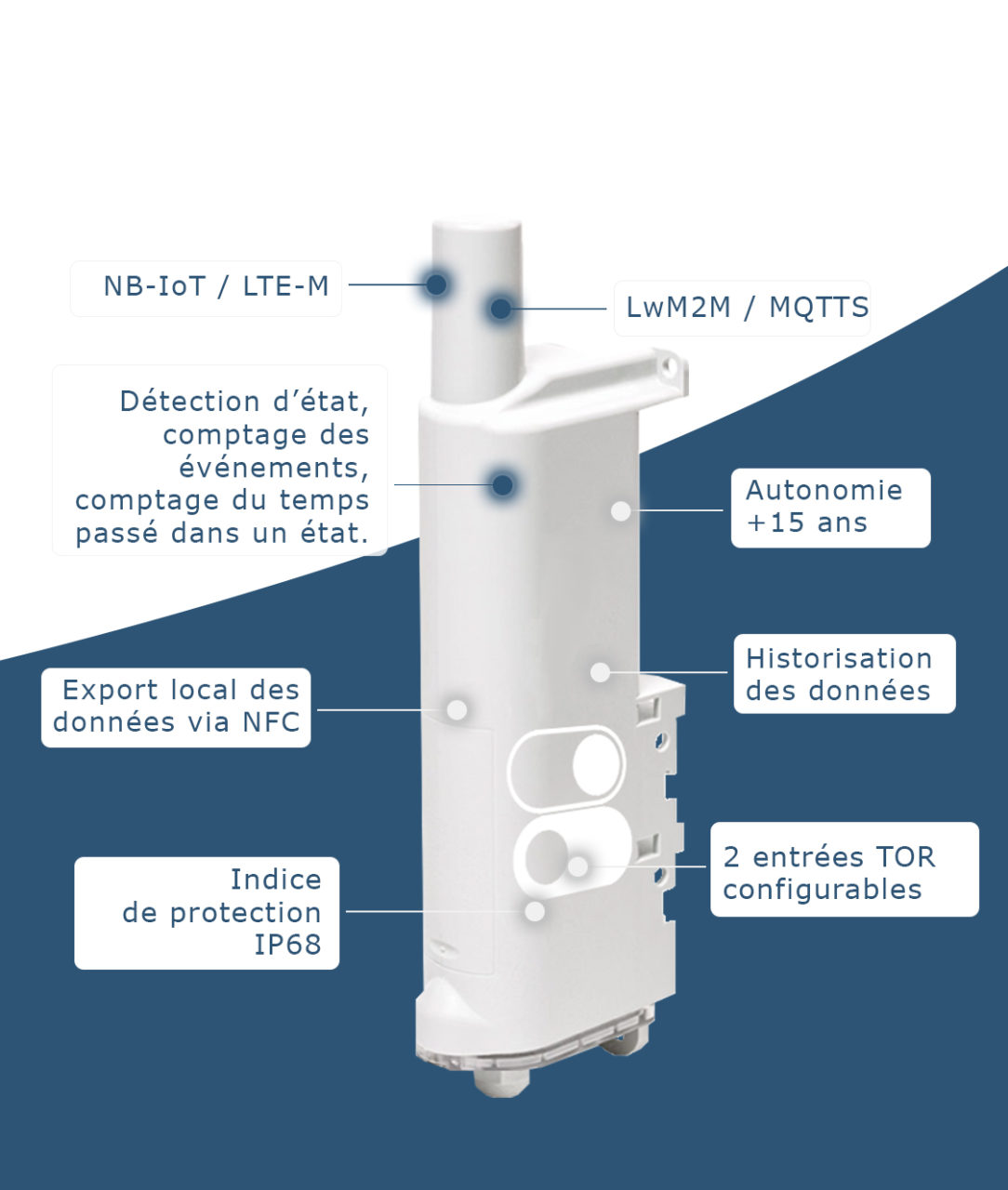When starting an IoT project, the choice of technology and the construction of the network architecture are among the essential questions to ask. LoRaWAN technology is now one of the pillars of the IoT and has established itself as an essential element in the world of connected objects.
When choosing LoRaWAN, the key question is whether to opt for a public (or operated) network, or a private network. To help you consider your options, here’s a comparison of these two solutions to help you bring your IoT project to fruition.
What is a LoRaWAN network?
LoRaWAN (Long-Range Wide-Area Network) is a radio communication protocol designed for transmitting small amounts of data at low bit rates and is particularly well suited to connected objects. The LoRaWAN protocol belongs to the LPWAN (low power wide area network) category.
A LoRaWAN-connected object can send a message from around 1 kilometre in an urban area (containing obstacles) and 20 kilometres in a flat rural area.
This long-range network is based on proprietary LoRa modulation technology. Therefore, this technology offers an extended range, while maintaining low energy consumption, enabling battery-operated products to have autonomies of several years.
Each LoRaWAN operator has its own network and therefore its own coverage map. More than 170 operators worldwide (as of 2023) offer a LoRaWAN network in more than 162 countries.
LoRaWAN uses free frequency bands (without royalties), which reduces network operating costs. It also allows the creation of private networks covering specific areas without subscription fees.
170
More than 170 operators in 162 countries
Private LoRaWAN
VS
Public LoRaWAN
What are the differences between LoRaWAN private vs public network?
Public network (or operated network) LoRaWAN
A public or operated LoRaWAN network is deployed and managed by telecom operators. The infrastructure is shared between users. This type of network offers vast geographical coverage for a large number of sensors.

+
Benefits
Extensive coverage: public networks, managed by operators such as Orange, cover vast geographical areas.
Easy to set up: you can quickly connect your sensors to the existing network without needing to deploy any special infrastructure.
Operator-managed network infrastructure: the public network is deployed and managed by a telecom operator.
Interoperability: LoRaWAN is a standardised and open protocol that enables devices from different manufacturers and organisations to communicate.
–
Disadvantages
Dependence on network coverage: if you are in an area with poor network coverage (e.g. a rural area or underground), the communication of your sensors will be limited.
Requires prior assessment: to ensure that your application works properly, it is best to assess the quality of network coverage and expected performance before deployment.
Business model: the business model is subscription-based. This can be costly if the number of sensors becomes large.
Limited control: organisations have limited control over network infrastructure and security policies.
LoRaWAN Private Network
A LoRaWAN private network is a network deployed locally, generally on a specific site (such as a company or municipality). It requires the installation of a dedicated infrastructure (including gateways and servers) belonging to the project owner.

+
Benefits
Total control and data security: private LoRaWAN networks offer total control over infrastructure, security policies and data management. Sensitive data remains within the boundaries of the organisation, reducing the risk of data breaches.
No operator subscription: once the architecture is in place, you don’t have to pay monthly or annual subscription fees.
Network coverage: deploying a private network can be an alternative to poor network coverage. Private networks offer predictable performance in terms of latency, reliability and coverage.
Customisation: private networks allow you to customise network architecture, frequency bands and deployment locations.
–
Disadvantages
Start-up infrastructure costs: you need to invest in infrastructure including gateways at the beginning of the deployment.
More complex maintenance and management: in a private network, you are independent and therefore responsible for maintaining and updating your infrastructure.
Coverage: private networks enable you to cover a restricted, specific geographical area.
Summary table: LoRaWAN private vs public network
| Criteria | Private network | Public network |
|---|---|---|
| Controle | Administrator has full control over network settings. | Access open to all (often with payment of a fee). |
| Coverage | Predictable, stable performance. Limited to the local area network (LAN) of the company. | Extended to the whole territory. May be limited in an environment with obstacles (buildings, hills, subsoil, etc.) or depending on the number of connected devices present in the area. |
| Installation | Requires the deployment of a specific infrastructure (sensor + gateway + server) | Fast, just need to connect the sensors |
| Data security | Total control, control of data confidentiality | Operator-managed security, shared data |
| Cost | Gateway purchase + subscription or linked licence if required | Subscription per sensor |
| Maintenance | Fast, just need to connect the sensors | Managed by the public operator |
| Interoperability | Customisable to specific needs | Standardised protocol, guaranteed interoperability |
| Dependency | Autonomous, without dependence on an external operator | Dependence on the coverage and quality of the operator's network |
| Flexibility | High, customisable architecture and frequencies | Less flexible, subject to operator conditions |
In conclusion, the choice between a public and a private network is specific to each project and depends on several factors. In all cases, to help you check the availability of the network (in the case of a public network architecture), or to validate the location of your gateways and sensors (in a private network), it is essential to carry out a radio-mapping study.
The comparison table below should help you make the decision that is best suited to your needs.
Frequently asked questions
LoRaWAN
LoRa and LoRaWAN are related but perform different functions within wireless communication networks.
LoRaWAN is the network protocol that links the LoRa signal (sensor data) to applications. In simple terms, LoRa is the radio signal that carries the data, and LoRaWAN is the communication protocol that controls and defines how that data is communicated across the network.
The main alternatives to LoRaWAN for long-range, low-power IoT networks include :
- Sigfox: A proprietary LPWAN network offering global coverage with very low power consumption.
- NB-IoT (Narrowband IoT): An LPWAN technology using existing cellular networks, ideal for urban and rural areas with wide coverage.
- LTE-M (LTE Cat-M1): A cellular IoT technology offering good coverage and mobility support, with higher data speeds than NB-IoT.
- Wi-Fi HaLow (802.11ah): A variant of Wi-Fi for IoT applications, offering extended range and lower power consumption.
- Zigbee: A wireless protocol for short-range mesh networks, used mainly in home automation and industrial applications.
Lhe frequencies used by LoRaWAN vary according to regional regulations. Here are the main frequency bands used by LoRaWAN:
- Europe: 863-870 MHz (under ISM band)
North America: 902-928 MHz (ISM sub-band) - Asia: Various bands, including 920-925 MHz (Japan), 923-925 MHz (Korea), and 865-867 MHz (India)
- Australia: 915-928 MHz (sub-ISM band)
These frequencies are chosen for their ability to enable long-range, low-power communications, which are essential for IoT applications.
Yes, LoRaWAN is secure. It incorporates end-to-end security from the outset, with multi-level encryption mechanisms. Each message is encrypted using keys unique to the device and the network, ensuring the confidentiality and integrity of the data transmitted. These security measures are designed to meet the needs of low-power, highly scalable IoT networks.
Intelligent buildings: energy management (monitoring energy consumption), security (intrusion detection), water management (leakage monitoring), air conditioning and heating control, etc.
Industry and logistics: machine monitoring (predictive maintenance), monitoring of environmental conditions (temperature, humidity), stock and warehouse management, etc.
Asset tracking and management: stock monitoring, vehicle fleet management, container and pallet tracking, etc.
Smart Cities: street lighting management, air quality monitoring, waste management (monitoring of skip fill levels), parking monitoring (detection of available parking spaces)
Intelligent agriculture: monitoring soil conditions (humidity, temperature), irrigation management, animal monitoring (livestock), crop monitoring (detection of diseases and pests), etc.
Health and well-being: monitoring patients (remote monitoring), managing medical equipment, monitoring the hospital environment
Environment and natural resource management: monitoring water levels (rivers, reservoirs), tracking weather conditions, monitoring flora and fauna.
What is the difference between LoRa® and LoRaWAN®?
LoRa and LoRaWAN are related but perform different functions within wireless communication networks. LoRaWAN is the network protocol that links the LoRa signal (sensor data) to applications. In simple terms, LoRa is the radio signal that carries the data, and LoRaWAN is the communication protocol that controls and defines how that data is communicated across the network.
Is LoRaWAN secure?
Yes, LoRaWAN is secure. It incorporates end-to-end security from the outset, with multi-level encryption mechanisms. Each message is encrypted using keys unique to the device and the network, ensuring the confidentiality and integrity of the data transmitted. These security measures are designed to meet the needs of low-power, highly scalable IoT networks.
What are the alternatives to LoRaWAN?
The main alternatives to LoRaWAN for long-range, low-power IoT networks include:
- Sigfox: A proprietary LPWAN network offering global coverage with very low power consumption.
- NB-IoT (Narrowband IoT): An LPWAN technology using existing cellular networks, ideal for urban and rural areas with wide coverage.
- LTE-M (LTE Cat-M1): A cellular IoT technology offering good coverage and mobility support, with higher data speeds than NB-IoT.
- Wi-Fi HaLow (802.11ah): A variant of Wi-Fi for IoT applications, offering extended range and lower power consumption.
- Zigbee: A wireless protocol for short-range mesh networks, used mainly in home automation and industrial applications.
What frequencies does LoRaWAN use?
The frequencies used by LoRaWAN vary according to regional regulations. Here are the main frequency bands used by LoRaWAN:
- Europe: 863-870 MHz (ISM sub-band)
- North America: 902-928 MHz (ISM sub-band)
- Asia: Various bands, including 920-925 MHz (Japan), 923-925 MHz (Corea), and 865-867 MHz (India)
- Australia: 915-928 MHz (ISM sub-band)
These frequencies are chosen for their ability to enable long-range, low-power communications, which are essential for IoT applications.
What are the most common applications for LoRaWAN?
Asset tracking and management: stock monitoring, vehicle fleet management, container and pallet tracking, etc.
Smart Cities: street lighting management, air quality monitoring, waste management (monitoring of skip fill levels), parking monitoring (detection of available parking spaces).
Intelligent agriculture: monitoring soil conditions (humidity, temperature), irrigation management, animal monitoring (livestock), crop monitoring (detection of diseases and pests), etc.
Intelligent buildings: energy management (monitoring energy consumption), security (intrusion detection), water management (leakage monitoring), air conditioning and heating control, etc.
Industry and logistics: machine monitoring (predictive maintenance), monitoring of environmental conditions (temperature, humidity), stock and warehouse management, etc.
Health and well-being: monitoring patients (remote monitoring), managing medical equipment, monitoring the hospital environment
Environment and natural resource management: monitoring water levels (rivers, reservoirs), tracking weather conditions, monitoring flora and fauna.
15/07/2024


